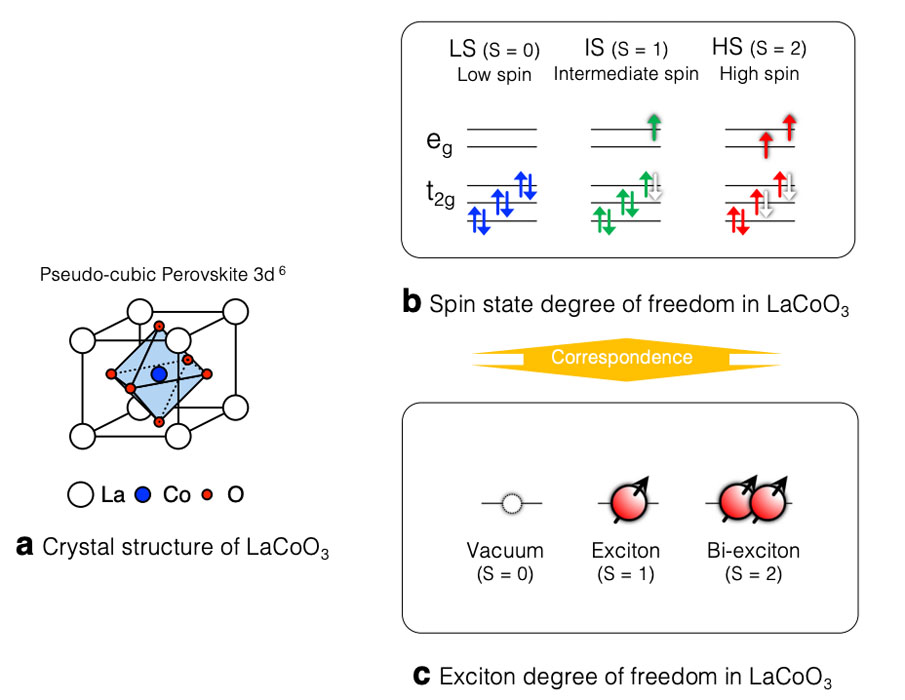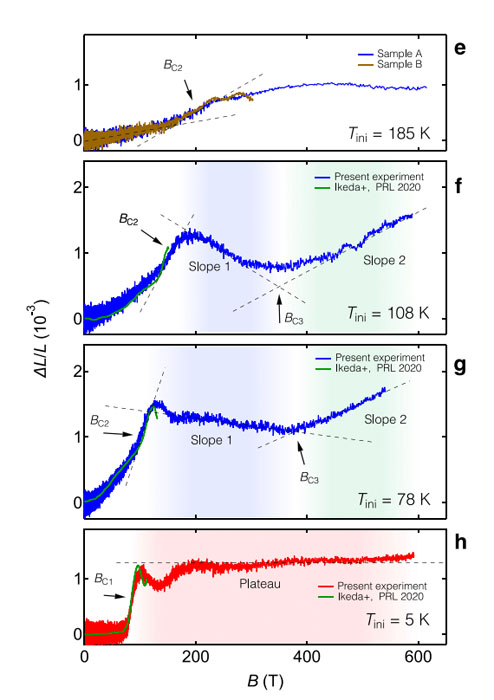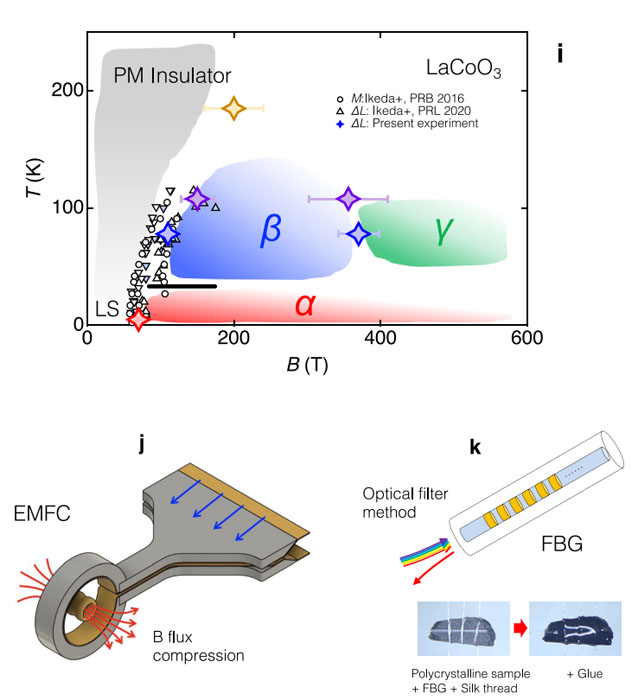Signature of Spin-Triplet Exciton Condensations in LaCoO3 at Ultrahigh Magnetic Fields up to 600 T
Y. H. Matsuda Group
Bose–Einstein condensation of electron-hole pairs, exciton condensation, has been effortfully investigated since predicted 60 years ago. Irrefutable evidence has still been lacking due to experimental difficulties in verifying the condensation of the charge-neutral and non-magnetic spin-singlet excitons. On the other hand, condensation of spin-triplet excitons is a promising frontier because spin supercurrent and spin-Seebeck effects will be observable. A canonical cobaltite LaCoO3 under very high magnetic fields is a propitious candidate, yet to be verified. In this study, we unveil the exotic phase diagram of LaCoO3 up to 600 T generated using the electromagnetic flux compression method and the state-of-the-art magnetostriction gauge. We found continuous magnetostriction curves and a bending structure, which suggest the emergence of two distinct spin-triplet exciton condensates. By constructing a phenomenological model, we showed that quantum fluctuations of excitons are crucial for the field-induced successive transitions. The spin-triplet exciton condensation in a cobaltite, which is three-dimensional and thermally equilibrated, opens a novel venue for spintronics technologies with spin-supercurrent such as a spin Josephson junction.
LaCoO3 has been claimed to be a promising candidate when placed under very high magnetic fields exceeding 100 T. LaCoO3 is an archetypal compound having a variety of spin-states, such as low-spin (LS: S = 0), intermediate spin (IS: S = 1) and high spin (HS: S = 2) states (See Fig. 1), which are viewed as vacuum, an exciton, and bi-exciton states, respectively (See Fig. 1). The spin-triplet exciton condensation will emerge when the magnetic field eliminates the spin-gap and changes the vacuum state (LS) to a magnetic exciton state (IS) or bi-exciton state (HS).
The experimental investigation has been challenging due to the need for very high magnetic fields beyond 100 T which is necessitated by the large spin-gap of ~100 K. Besides, one needs to probe the exciton states at such high magnetic fields. As solutions to these difficulties, recently, we reported the generation of 1200 T with electromagnetic flux compression (EMFC) method using a newly installed capacitor banks system in ISSP [3]. Furthermore, we succeeded in implementing a state-of-the-art high-speed 100 MHz strain gauge using fiber Bragg grating (FBG) and optical filter method, which have enabled us to measure magnetostriction in the μs-pulsed 1000 T environment [4]. Magnetostriction is a crucial probe of the exciton states because the density of excitons is coupled to the lattice volume of LaCoO3, where exciton and bi-exciton states have larger ionic volumes with the occupation of eg orbitals that is spatially more extended than t2g orbitals as can be seen in the correspondence of spin-states and exciton states. Solidifications and Bose-Einstein condensations of excitons result in plateaus and slope of exciton density. Thus, we expect that they also result in plateaus and slope in magnetostriction curves at very low temperatures. Note that the correspondences are analogs to the magnetization plateaus and slopes in magnon solids and superfluids, respectively.
The results of magnetostriction measurements up to 600 T are presented in Fig. 2. The new features indicating magnetic field induced phase transitions are observed. We summarize the obtained results in the present and previous studies on a magnetic field – temperature plane as shown in Fig. 3.
Previously in LaCoO3, the field-induced phase transitions are uncovered below 30 K (α phase) and above 30 K (β phase), which extend beyond 100 T, using magnetization [1] and magnetostriction measurements [2] up to 200 T generated by single turn coil (STC) method. The two phases are considered superlattice formation (i.e., solidification) of the excitons, bi-excitons, and vacuum based on the observation of plateaux of magnetostrictions. Considering that the magnetization below 200 T is far from the full polarization of the spin-states, further orderings of excitons are expected to appear above 200 T.
In addition to the data up to 600 T for the α phase and the β phase, we found novel phase termed γ phase. The variety of phases indicates the exotic ordering of the exciton degree of freedom in LaCoO3. We qualitatively discuss the possibility of two kinds of spin-triplet exciton condensation realized in LaCoO3 corresponding to the β phase and the γ phase. We attributed the origin of the α phase to be a crystallization of excitons. The study indicates the complicated interactions and symmetry breakings are in play in LaCoO3 placed at ultrahigh magnetic fields [5].
References
- [1] A. Ikeda, T. Nomura, Y. H. Matsuda, A. Matsuo, K. Kindo, and K. Sato, Phys. Rev. B 93, 220401(R) (2016).
- [2] A. Ikeda, Y. H. Matsuda, and K. Sato, Phys. Rev. Lett. 125, 177202 (2020).
- [3] D. Nakamura, A. Ikeda, H. Sawabe, Y. H. Matsuda, and S. Takeyama, Rev. Sci. Instrum. 89, 095106 (2018)
- [4] A. Ikeda, T. Nomura, Y. H. Matsuda, S. Tani, Y. Kobayashi, H. Watanabe, and K. Sato, Rev. Sci. Instrum. 88, 083906 (2017).
- [5] A. Ikeda, Y. H. Matsuda, K. Sato, Y. Ishii, H. Sawabe, D. Nakamura, S. Takeyama, and J. Nasu, Nat. Commun. 14, 1744 (2023).



